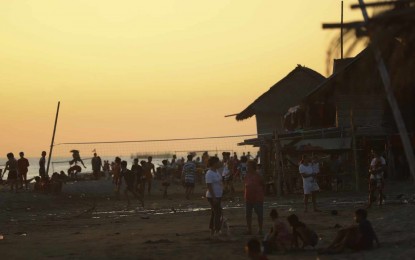
BLACKOUT. Residents of Iloilo City’s coastal barangay of Calaparan stay along the coastlines while waiting for power to be restored on Jan. 5, 2024. In a news forum on Saturday (Jan. 6, 2024), Energy Regulatory Commission chairperson Monalisa Dimalanta said power plant operators, not just the National Grid Corp. of the Philippines, may also be held accountable for the massive power outage in Western Visayas. (Photo courtesy of Iloilo City Mayor’s office)
MANILA – The investigation into the massive power outage in Western Visayas may be completed in six to eight weeks, the Energy Regulatory Commission (ERC) said on Saturday.
During the Saturday News Forum in Quezon City, ERC chairperson Monalisa Dimalanta said the power plant operators, not just the National Grid Corp. of the Philippines (NGCP), may also be held accountable for the Western Visayas blackout.
Dimalanta said the possible sanctions that could be imposed against the NGCP and the power plant operators would be determined after the investigation.
“Hindi po din natin basta ine-excuse nga for example ang mga planta. Kasi puwede pong doon sa anim na planta, meron po ba doon na hindi nag-maintain ng standards. For example, meron po ba doong bumitaw ng mas maaga under the Grid Code? Kapag po ganoon, may penalty din po siya. Hindi lang po NGCP kung nakita po talaga natin na hindi niya ginawa ang trabaho niya (We don't just excuse the power plants for example. Because the six power plants may have lapses in maintaining standards. For example, did any of them fail to follow the Grid Code? In that case, they may also be penalized. It's not just NGCP, if we find that they didn't do their job),” she said.
“This time around, (it may take) maybe around six to eight weeks for us to complete the investigation. And then, doon po sa tanong niyo kung NGCP lang ba, tingin ko po masasagot ko iyan after the investigation (as to your question if it's just NGCP, I think I can answer that after the investigation).”
Dimalanta also noted that the NGCP is facing backlash because it is acting as the “main actor” in operating, maintaining, and developing the country’s state-owned power grid.
She said the ERC is expected to gather more information about the region-wide blackout by next week.
Power outages hit the islands of Panay, Guimaras, and Negros due to the trip-offs of the Panay Energy Development Corp. (PEDC) Units 1 and 2, as well as the Palm Concepcion Power Corp. Unit 1.
Dimalanta said the power supply in the Western Visayas is already “normal and stable.”
President Ferdinand R. Marcos Jr. on Friday directed ERC to hasten the completion of the rate reset review for NGCP in the wake of the power crisis in Western Visayas.
The PHP7.09 billion difference, equivalent to PHP35 billion for five years, between the ERC-determined annual revenue requirement (ARR) of NGCP of PHP36.7 billion and the annual maximum annual revenue (MAR) of PHP43.789 billion collected by NGCP from consumers through the transmission charge from 2016 to 2020, will most likely be refunded to consumers.
This would be reflected in lower transmission rates on power consumers' electricity bills. The ARR of PHP36.7 billion is contained in the results released by the ERC as part of its partial initial determination for NGCP's rate reset covering the years 2016 to 2020.
Dimalanta said the rate reset is crucial to prevent similar power outages in the future.
“Ang epekto po ng pag-reset ng rates ay (The effect of resetting the rates is) nationwide,” she said.
“It allows us and NGCP to already set the investment requirements for the future. ‘Yun po talaga ang hinahabol natin dito – ano ba ang kailangang investments for the future para po maiwasan na nga itong nang nangyayaring ganito (That's what we're really after here – what investments are needed for the future to prevent this from happening) so that we can all make the grid more resilient, more responsive, more adaptive to the current mix of generation that we have and the future expansion of generation.” (PNA)
